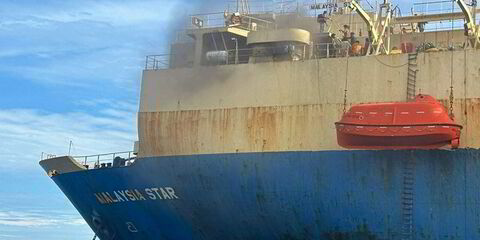French LNG cargo containment system designer GTT forecasts shipyard berths for LNG carriers increasing towards the 100 per year mark starting in 2028.
Speaking on a third-quarter results call, GTT chief executive Jean-Baptiste Choimet said LNG carrier market is demand driven and yards have been increasing their slots.
Choimet said there are currently about 70 shipyard slots per year available for LNG carriers.
“We anticipate this rising to around 85 slots by 2026 mainly due to the ramping up of Chinese shipyards,” he said. “We believe that the number of slots could keep rising.”
In response to analysts’ questions, he said a rise of 10 to 15 slots by 2028 “sounds like a reasonable number”.
One factor that could limit this is if the supply chain fails to keep place, he added.
GTT saw its revenue for the first nine months of 2024 soar by 55% to €464.7m ($501.9m) compared with €300m in the same period of last year.
Chief financial officer Thierry Hochoa said this is due to orders for newbuildings, and bookings received in 2021 for LNG-fuelled vessels. He said the company is also seeing good momentum in the services it is supplying to vessels. But its electrolyser business, Elogen, logged small fall in revenue as hydrogen uptake slowed.
During the first three quarters of this year, GTT netted 82 new orders for its membrane-type containment systems. That included 68 LNG carriers, 12 ethane carriers, one floating storage and regasification unit and a floating LNG production. The company also scored 13 new contracts to design the bunker tanks for vessels that will use LNG as fuel.
Choimet said GTT’s orderbook stands at “an all-time” high. As of September, the company listed 350 orders — up from 311 in December 2023 — comprising 325 LNG carriers, 16 ethane vessels, two FSRUs, two FLNG units and five onshore tanks.
GTT is also sitting on 61 orders for LNG bunker tanks for vessels that will use the fuel.
The company estimated that for the liquefaction plants already under construction, to transport this 175 mtpa of new capacity some 285 LNG carriers will be needed.
Choimet said about 200 ships have already been secured leaving 85 ships required in the near future. The company’s figures showed a possible 25 unchartered modern LNG carriers which could slim this requirement to nearer 60 vessels.
Momentum
The relatively new CEO, who took up the post in June, said the take up of LNG as a fuel is “gaining momentum”. “We are seeing early methanol adopters shifting back to LNG as their fuel of choice,” he said.
But he said the limited availability of shipyard slots poses a problem for membrane tank technology while the alternative type B and type C tanks are being “aggressively promoted”.
Chinese yards often outsource these tanks but GTT keeps working with them and with owners to explain the advantages of its technology, Choimet said.
He said GTT is continuing to innovate and highlighted the company’s new 200,000-cbm, three-tank LNG carrier design.
Choimet said GTT is “leading the way” with its development of the 150,000-cbm ultra large ethane carrier for which the company’s Mark III membrane technology gives a lighter ship weight and so a shallow draught giving access to most ports.
Asked if the company overestimated the demand for large ethane carriers, he said: “We believe that thanks to our innovative ULEC design we will trigger interest from shipowners.”
The CEO said that in the absence of yard delays and with improved visibility for the end of the year, GTT expects to reach the top of the range in its full-year revenue guidance of €600m to €640m.






